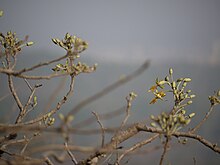Genus of flowering plants
Eriolaena is a genus of flowering plants. Traditionally included in the family Sterculiaceae, it is included now in the recently expanded Malvaceae.[2] The genus is distributed in Asia and eastern Africa, from southern China through Indochina to India, Bangladesh, Nepal, Sri Lanka, Madagascar, and coastal Mozambique.[1][3][4]
These plants are trees or shrubs. They usually have single or paired white or yellow flowers, but some species have larger inflorescences. The fruit is a hard capsule with winged seeds.[3] The winged seeds make the genus distinctive in its family.[5]
The former Madagascan genera Helmiopsiella and Helmiopsis are now considered synonyms of Eriolaena.[1] These genera were named in honour of C. Helm, German clergyman in Berlin and amateur botanist.[6]
Species
27 species are currently accepted.[1]
- Eriolaena barnettiae Dorr – Madagascar
- Eriolaena bernieri (Baill.) Dorr – northern Madagascar
- Eriolaena boivinii (Baill.) Dorr – northwestern Madagascar
- Eriolaena calcicola (Arènes) Dorr – northwestern Madagascar
- Eriolaena candollei Wall. – India and Bangladesh, Indochina, southern China
- Eriolaena cheekii Dorr – Madagascar
- Eriolaena ctenostegia (Hochr.) Dorr – western Madagascar
- Eriolaena glaberrima (Arènes) Dorr – northern Madagascar
- Eriolaena hily (Arènes) Dorr – southwestern and southern Madagascar
- Eriolaena hookeriana Wight & Arn. – India and Sri Lanka
- Eriolaena leandrii (Hochr.) Dorr – Madagascar
- Eriolaena linearifolia (Hochr.) Dorr – northern Madagascar
- Eriolaena lushingtonii Dunn – Eastern Ghats (southern India)
- Eriolaena madagascariensis (Arènes) Dorr – Madagascar
- Eriolaena margaritae Dorr – Madagascar
- Eriolaena parvifolia (Appleq.) Dorr – southwestern Madagascar
- Eriolaena poissonii (Arènes) Dorr – northwestern Madagascar
- Eriolaena polyandra (Appleq.) Dorr – northern Madagascar
- Eriolaena pseudopopulus (Baill.) Dorr – northern Madagascar
- Eriolaena quinquelocularis (Wight & Arn.) Drury – India and Yunnan (China)
- Eriolaena richardii (Baill.) Dorr – northern Madagascar
- Eriolaena rigida (Baill.) Dorr – Madagascar
- Eriolaena rulkensii[4] Dorr – northern Mozambique
- Eriolaena spectabilis (DC.) Planch. ex Mast. – Himalayas (India, Nepal, Bhutan), northern Myanmar, Yunnan, Guizhou, and Guangxi (China)
- Eriolaena sphaerocarpa (L.C.Barnett) Dorr – northern Madagascar
- Eriolaena stocksii Hook.f. & Thomson ex Mast. – western and northeastern India
- Eriolaena wallichii DC. – Nepal, Arunachal Pradesh (India), northern Myanmar, Yunnan (China)
References
